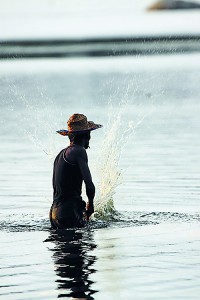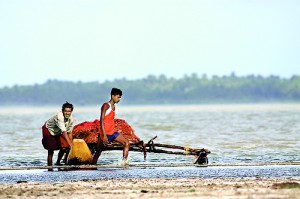Wise use of our wetlands can reduce poverty and promote biodiversity
Wetlands are important environments for people, wildlife and plants. They provide freshwater, food and services, such as medicines, fuel and wildlife tourism, and contribute to the livelihoods of millions of the world’s poor.
Wetlands are also critical to a country’s water table. They soak up water much like a sponge and prevent flooding during periods of heavy rainfall, by holding water whenever water levels rise and slowly releasing water when levels are low. They help keep river levels normal, and filter and purify the surface water. They release vegetative matter into rivers, which feed marine life. Many birds and animals living in other habitats use wetlands to migrate or reproduce.
About 6% of the world’s land is classified as either permanent or seasonal wetland. Researchers estimate that wetlands are worth about USD 70 billion every year, globally.
Yet, for centuries, people around the world saw wetlands as unproductive land that is difficult to access and farm, and the source of disease and floods.
Although these attitudes have now changed in most parts of the world, severalwetlands in Sri Lanka are still being drained and built upon or used as garbage dumps.

Sustainable or not? A fisherman beats the water to chase fish into nets at the Palatupana lagoon
Limits
Wetlands have many uses, but they must be exploited sustainably. These are dynamic ecosystems that change naturally over time due to processes such as erosion, sedimentation and coastal flooding. Human activity within or in surrounding areas can alter these natural processes and threaten the continued existence of wetlands. Income-generating activities may become unsustainable, if a wetland is either too small to support the local population or too many people migrate towards it to benefit from its potential. This leads to degradation of wetlands, which can cause a downward spiral that may result in its extinction: as wetlands alter, they provide less services and push people further into poverty, which causes them to intensify extractive activities that, in turn,cause further degradation.
The Negombo Lagoon faces intensive pressure from the dense population living around it. This lagoon sustains a thriving fishing industry and has extensive mangrove swamps,which are home to a variety of birds and plants.Its capacity is reducing as it fills with sediment washed downstream and waste dumped by households and industries, and mangroves are cut to make brush parks for shrimp farming. The quantities of water in wetlands,the fish it provides,and the bird and plant life it sustains are now lessening.
Threats
Agriculture is considered as the most significant threat to a wetland’s continuity. This is due to the scale and nature of wetland agriculture, which has intensified in recent years, and extensively and irreversibly modified many wetlands. Many have been drained to grow crops, their water has been diverted and over-extracted, and they have also been polluted by fertilisers and pesticides.
Upstream agriculture can also reduce the flow of water into wetlands, and may also increase surface runoff and soil erosion, which builds up the amount of sediment entering a wetland. The Embilikala lagoon has been affected by agricultural practices upstream. Water is being extracted for agriculture and then released continually. This has ended the natural cycle of flooding and drying in the lagoon, while runoff from agricultural land has increased the amount of sediment in the water. As a result, the foraging habits of shoreline birds in the lagoon have changed, notably their feeding efficiency has reduced. Many species require shallow water for feeding, but the changes in the water table mean that the water is now much deeper and is leading to declines in many bird varieties.
Urban development and water extraction for industry can have extreme impacts on wetlands located downstream. As populations increase and demand more food, and there is greater economic development, wetlands need to be conserved. Managing wetlands is key to conservation, but this is a challenging task: decision-makers must balance the need to conserve wetlands, and the wide range of services they provide, with the changing needs of the people who use and depend on them. Often, local users, conservationists, businesses and governments serve their own interests when deciding on how a wetland should be managed, and the needs and values of the poor it sustains can go unrecognised in the decision-making processes.
The Ramsar Convention, an intergovernmental treaty on wetland conservation, supports moving away from the absolute protection of  wetlands to integrating their conservation with development. A growing consensus that seeks to optimise the benefits of wetlands for smallholder farming to reduce poverty, while simultaneously protecting biodiversity and ecosystems, supports this approach.
wetlands to integrating their conservation with development. A growing consensus that seeks to optimise the benefits of wetlands for smallholder farming to reduce poverty, while simultaneously protecting biodiversity and ecosystems, supports this approach.
Using case studies and research, the International Water Management Institute (IWMI), headquartered in Colombo, launched a book, ‘Wetlands and people’, which argues for a more ‘people-centred’ approach to managing wetlands. The book illustrates the benefits and services wetlands provide in Asia, Africa and Latin America, and discusses ways in which wetlands could be managed sustainably for generations to come.
“Outright protection of wetlands is incompatible with farming and would threaten the livelihoods of millions of people, and we’ve seen these approaches fail in the past,” said Matthew McCartney, a hydrologist at IWMI, and a contributor to the book,Wetlands and people. “But there are agricultural practices that can support and sustain healthy wetlands, and vice versa. Working with local communities will help us find the best solutions.”
Agriculture
Many wetlands are suitable for agriculture,but competing demands for different types of agriculture must also be considered. The Kalametiya lagoon is used for growing rice and for fishing, but changes to the lagoon have increased competition between rice paddy farmers and fishermen. Bunds (barriers) built to prevent the paddy fields flooding, along with an outlet built to channel irrigation water to the sea (rather than the wetland), have reduced the flow of water to the lagoon and led to a decrease in its size. This has resulted in a drastic decline in the number of people that are able to earn a living from fishing. The fishermen want to see the bunds destroyed and the outlet channel blocked, but this would affect rice production.


